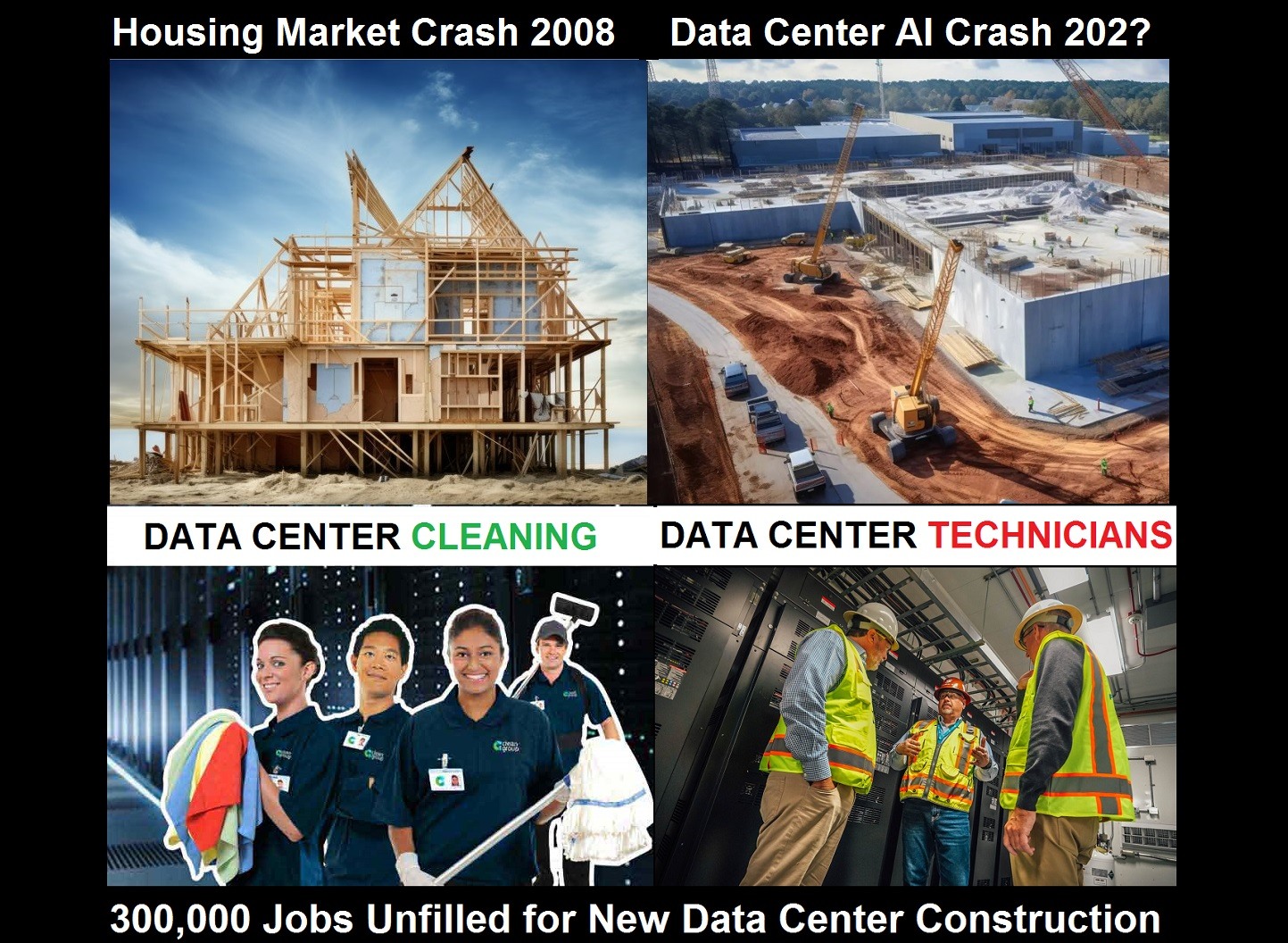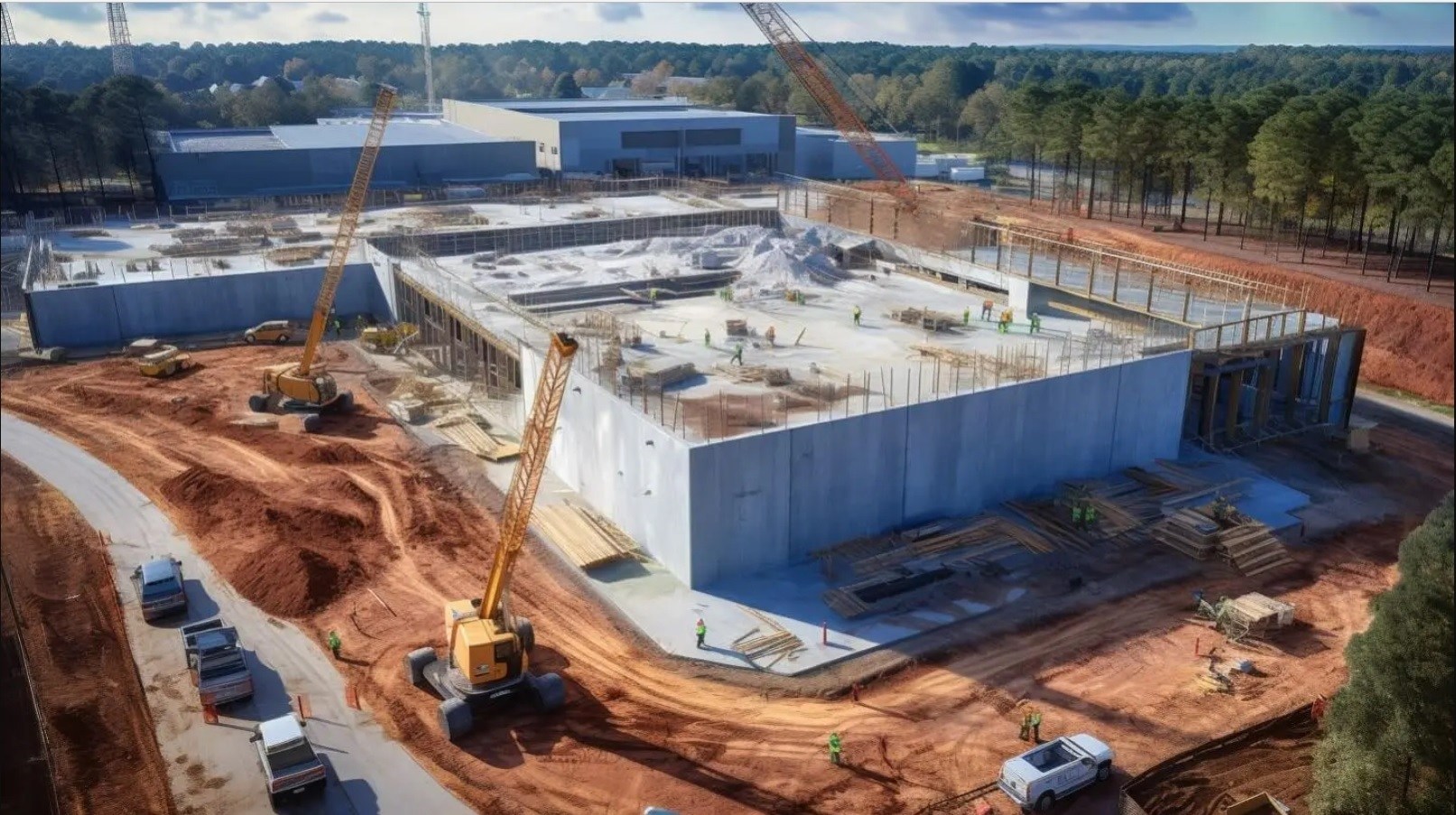
by Brian Shilhavy
Editor, Health Impact News
I think many Americans are about to learn that math is very unforgiving, and always produces the same number based on the numerical data used for mathematical calculations, regardless of beliefs, illusions, cons, and science fiction.
You can believe yourself, and try to convince others to believe that 2 + 2 does NOT equal 4, but something else like 5.
But just like AI, math has no consciousness and creates nothing. It just reports the mathematical results based on the data input, which is how the REAL world works, as opposed to the FAKE world, and their FAKE (artificial) intelligence.
Reality is now catching up to the fantasy land of “generative AI”, and we are drawing nearer to the crash of the great AI bubble every day. The money merry-go-round among Big Tech with their AI investments shows no sign of abating yet, with Nvidia currently sitting on the top of the bubble holding the largest bag of money.
But the signs are now showing that this AI show may soon be over, as the only way forward at this point is to build huge new power-hungry data centers.
And while it is debatable if the economy can come up with new ways to generate more power to run these data centers, one thing is not debatable: to build and maintain these data centers requires a huge increase in human labor, and we do not have that labor in the U.S. workforce right now.
In fact, many of these skilled jobs are currently run by immigrant labor where the supply line to this cheap labor has not only been cut off at the borders, but is decreasing with mass deportations.
The U.S., and the entire world, are about to get a rude lesson in math, and wake up to the fact that science fiction is just that – fiction, which is based on fake (artificial) intelligence.
The robot revolution to replace humans will soon be canceled, due to a lack of humans to build them and maintain them.
Data Center Construction Delays Exemplify how Reality Trumps Hype

An unfinished data center construction site. These are popping up all over the U.S. right now. Image source.
Anissa Gardizy, writing for The Information just published an article today titled: “As AI Data Centers Face Delays, the Blame Game Begins”
Excerpts:
The mood is shifting in AI data center circles. The euphoria of record-setting, multi-gigawatt deals has given way to finger pointing as deadlines to get AI servers online slip or get dangerously close to falling behind.
For months, data center builders have told me many of the gigawatt-size AI server facilities are running behind schedule because of the complexities of putting together the biggest clusters of servers ever attempted.
[T]he stakes are different now, given the urgency to complete AI data centers.
Earlier this year, Oracle executives raised their voices at contractors in Abilene, Texas, as pressure mounted on the company to hand over working servers to its customer, OpenAI.
The executives had good reason to be frustrated.
We’ve heard cloud providers’ contracts with customers include provisions in which customers can pay less if the provider misses a timeline or if the servers aren’t functioning properly, reducing their uptime.
For GPU cloud providers with already thin gross profit margins on renting out servers, these problems can materially alter their financial results.
The race to get Nvidia GPU clusters online continues to be a challenge for some firms that promised speedy timelines. And it’s likely that as power becomes harder to secure, which could also cause delays, we might see customers hedging their bets by working with multiple data center providers.
Several developers told me this week GPU shipments are outpacing construction timelines so severely that some firms are storing racks of idle GPUs in warehouses, waiting to be told where to send them.
Even Meta acknowledged this tension on its earnings call in late October. Chief Financial Officer Susan Li said the company is now “staging data center sites,” or essentially getting them ready with everything but the GPU racks, so Meta can “spring up capacity quickly in future years as we need it.”
In other words, even large data center developers like Meta are building buffers to prepare for capacity spikes.
One thing is clear: We’re entering an era where the physical limits of labor, equipment, utilities and contractor bandwidth are colliding with customer demand.
It’s going to be a bumpy ride. (Full article – subscription needed.)
Here is what Microsoft CEO Satya Nadella said earlier this month:
Microsoft CEO Satya Nadella didn’t mince words in his appearance on the Bg2 Pod with investor Brad Gerstner and OpenAI’s Sam Altman.
The tech leader made a startling admission that the biggest problem facing AI expansion right now isn’t chips — it’s power.
In what was a rare moment of candor, Nadella confessed that Microsoft has some of the most cutting-edge GPUs sitting idle because there’s basically nowhere to plug them in.
“I don’t have warm shells to plug into,”
he said, referring to unfinished data center facilities that don’t have power or cooling capacity.
It’s a stunning admission from arguably the world’s most resource-rich companies, and a potential reality check for the entire AI boom.
With industries across the globe racing to build smarter machines, it’s hitting a very human limit; there might not be enough electricity to keep the dream running. (Source.)
300,000 New Data Center Jobs Unfilled due to Shortage of Human Labor

The lack of human resources to build these new data centers is well documented, but this problem is not headline news and you have to search for it to see how severe the problem is.
This is a study that was published recently on LinkedIn:
The Shortage of Skilled Personnel in Data Centres: Challenges, Causes and Mitigation Strategies
Excerpts:
Data centre sector faces a critical challenge: the growing shortage of specialised personnel. This article analyses the structural causes of the issue, the operational and strategic risks it entails, and the main mitigation measures, including training programmes, workforce reskilling, retention strategies, and the incorporation of Artificial Intelligence (AI) as a partial support mechanism.
Recent data from the Uptime Institute, the Bureau of Labor Statistics (BLS), and industry reports are presented to support the analysis.
The rapid digitalisation of society and the growth of cloud computing, Artificial Intelligence (AI), edge computing and 5G have exponentially increased the demand for critical infrastructure.
Data centres, as the backbone of this ecosystem, are undergoing unprecedented expansion. The global data centre services market is expected to reach USD 110 billion by 2030, up from USD 62 billion in 2024, representing a compound annual growth rate (CAGR) of nearly 10% (Data Center Services, 2024).
This growth contrasts with a structural limitation: the availability of specialised personnel to design, build, operate, and maintain highly critical facilities. The talent shortage represents a strategic risk that could compromise the sector’s ability to sustain its expansion.
The Uptime Institute estimates that the global data centre workforce will increase from 2 million professionals in 2019 to 2.3 million in 2025, leaving a shortfall of approximately 300,000 positions.
In Europe and North America, a significant proportion of the technical workforce is approaching retirement, exacerbating the shortage. In the United States, the Bureau of Labor Statistics (BLS) forecasts an 11% increase in demand for electricians by 2033, nearly three times the average for other professions (Barron’s, 2025).
Root Causes
- Educational misalignment: Most engineering programmes lack specific training on data centre operations and management, leaving employers to fill the gap with on-the-job training.
- High turnover: The demands of 24/7 availability, shift work, and operational pressure contribute to burnout and early exit.
- Cross-sector competition: Energy, telecommunications, oil & gas, and cybersecurity industries all compete for the same technical talent, inflating salaries.
- Limited sector visibility: Unlike fintech or AI, data centres are not widely perceived as an attractive career path for young engineers (Mission Critical Magazine, 2024).
Risks Arising from the Shortage
- Increased operational risk: 70% of service disruptions in data centres are linked to human error (Uptime Institute, 2023). Lack of experience amplifies this vulnerability.
- Delays in expansion: Workforce scarcity slows down the construction and commissioning of new facilities, affecting time-to-market.
- Rising labour costs: Competition for skilled profiles drives salaries higher and reduces operating margins.
Human labor is needed for all aspects of building all these new data centers, including the enormous increase in power needed to generate the electricity that is needed to run these data centers.
2025 Data Center Construction: Permits, Power, and Risks
Excerpts:
The global demand for data, driven by the AI revolution and our ever-connected world, has triggered an unprecedented boom in data center construction.
However, developers and investors are facing a perfect storm of obstacles that are slowing projects, inflating costs, and reshaping the industry landscape. As we look toward 2025, moving from concept to a fully operational facility has become more complex than ever.
The primary challenges are not about a lack of will or capital, but about fundamental constraints in power, permissions, and resources.
For years, the biggest hurdles in data center development were land acquisition and fiber connectivity. Today, one factor stands above all others: power.
The primary obstacle to new data center development is securing access to sufficient, reliable power. The energy demands of modern data centers, especially those designed for high-density AI and machine learning workloads, are staggering. This immense appetite for electricity is straining local and national power grids, many of which were not designed for such concentrated loads.
Key power-related challenges include:
- Grid Capacity Limitations: Many established data center hubs, like Northern Virginia and Silicon Valley, are facing power moratoriums or significant delays. Utilities simply cannot supply the multi-megawatt connections required for new hyperscale projects in a timely manner.
- Lengthy Timelines for Substations: Getting a new substation planned, approved, and built can take several years. This timeline is often longer than the construction of the data center itself, creating a major scheduling bottleneck.
- The Push for Sustainability: While essential, the transition to renewable energy sources adds another layer of complexity. Developers must now consider not only the availability of power but also its source, as clients and regulators increasingly demand sustainable operations.
Even with power secured and permits in hand, the physical construction of a data center is hampered by ongoing global supply chain disruptions and a critical shortage of skilled labor.
The demand for specialized data center equipment far outstrips the current supply.
Critical components like high-capacity generators, switchgear, and advanced cooling systems can have lead times exceeding 18-24 months. This forces developers to place orders long before they are needed, tying up capital and creating significant financial risk if a project is delayed for other reasons.
Simultaneously, the industry is grappling with a severe talent gap.
A shortage of skilled labor—including electricians, engineers, and construction managers with data center experience—is driving up costs and extending project timelines.
The complexity of modern facilities requires a specialized workforce that is currently in short supply, leading to fierce competition for qualified professionals.
Just in the area of general contractors who work with concrete and build buildings, there is already a huge shortage of construction workers which is getting worse every day due to the Trump administration’s ongoing immigration raids which deport many immigrants who are here legally, taking them right out of the workforce.
1.2 Million Immigrants have left the Labor Force since January
Excerpts:
- A UCLA study documents that Latino immigrants comprise 16% of California’s workforce and 14% in Texas, dominating construction, agriculture and service-sector jobs nationwide.
- ICE raids are forcing Latino immigrant workers into hiding across the country, threatening economies in both red and blue states that depend heavily on their labor.
- Data show 1.2 million immigrants have left the labor force since January, prompting the Congressional Budget Office to downgrade its economic growth forecast.
“Latino immigrants are indispensable to the U.S. economy, because they support industries that are difficult to automate or outsource,” wrote Arturo Vargas Bustamante, one of the authors of the findings in a news release.
“Noncitizens, who we found include the majority of Latino immigrant labor, are a flexible labor force that adapts to the business cycle, particularly during economic growth periods when additional labor is needed.
Recent escalation in immigration enforcement puts economies at risk of losing large shares of this workforce, which contributes trillions of dollars to the U.S. GDP.”
Those hard-to-automate industries are the construction, agricultural and service sectors.
The growth in Latino immigrant construction workers has far outpaced the general growth of the industry in each of the 10 surveyed states.
The AI Revolution is about to crash due to a lack of Human Labor.
Math and the numbers do not lie, but the Technocrats do, and Wall Street is following their lies inflating what might be the largest financial bubble in human history.
Related:
Mathematical Proof vs. Scientific Proof: Are They the Same?
Comment on this article at HealthImpactNews.com.
This article was written by Human Superior Intelligence (HSI)
See Also:
Understand the Times We are Currently Living Through
The Demonic Roots of Christianity: The Christians Jesus Said He Hated
Who are God’s “Chosen People”?
Life in the Spirit versus the Religious Life in the Flesh
KABBALAH: The Anti-Christ Religion of Satan that Controls the World Today
Christian Teaching on Sex and Marriage vs. The Actual Biblical Teaching
Exposing the Christian Zionism Cult
The Bewitching of America with the Evil Eye and the Mark of the Beast
Jesus Christ’s Opposition to the Jewish State: Lessons for Today
Identifying the Luciferian Globalists Implementing the New World Order – Who are the “Jews”?
The Brain Myth: Your Intellect and Thoughts Originate in Your Heart, Not Your Brain
The Seal and Mark of God is Far More Important than the “Mark of the Beast” – Are You Prepared for What’s Coming?
The Satanic Roots to Modern Medicine – The Image of the Beast?
Medicine: Idolatry in the Twenty First Century – 10-Year-Old Article More Relevant Today than the Day it was Written
Having problems receiving our emails? See:
How to Beat Internet Censorship and Create Your Own Newsfeed
We Are Now on Telegram. Video channels at Bitchute, and Odysee.
If our website is seized and shut down, find us on Telegram, as well as Bitchute and Odysee for further instructions about where to find us.
If you use the TOR Onion browser, here are the links and corresponding URLs to use in the TOR browser to find us on the Dark Web: Health Impact News, Vaccine Impact, Medical Kidnap, Created4Health, CoconutOil.com.



















